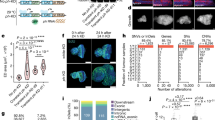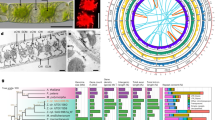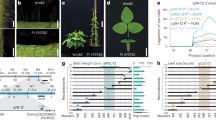Abstract
Polycomb group (PcG)-mediated histone H3 lysine 27 trimethylation (H3K27me3) has a key role in gene repression and developmental regulation1,2,3,4. There is evidence that H3K27me3 is actively removed in plants5,6,7,8, but it is not known how this occurs. Here we show that RELATIVE OF EARLY FLOWERING 6 (REF6), also known as Jumonji domain–containing protein 12 (JMJ12), specifically demethylates H3K27me3 and H3K27me2, whereas its metazoan counterparts, the KDM4 proteins, are H3K9 and H3K36 demethylases9,10. Plants overexpressing REF6 resembled mutants defective in H3K27me3-mediated gene silencing. Genetic interaction tests indicated that REF6 acts downstream of H3K27me3 methyltransferases. Mutations in REF6 caused ectopic and increased H3K27me3 level and decreased mRNA expression of hundreds of genes involved in regulating developmental patterning and responses to various stimuli. Our work shows that plants and metazoans use conserved mechanisms to regulate H3K27me3 dynamics but use distinct subfamilies of enzymes.
This is a preview of subscription content, access via your institution
Access options
Subscribe to this journal
Receive 12 print issues and online access
$209.00 per year
only $17.42 per issue
Buy this article
- Purchase on Springer Link
- Instant access to full article PDF
Prices may be subject to local taxes which are calculated during checkout





Similar content being viewed by others
Accession codes
References
Zhang, X. et al. Whole-genome analysis of histone H3 lysine 27 trimethylation in Arabidopsis. PLoS Biol. 5, e129 (2007).
Hennig, L. & Derkacheva, M. Diversity of Polycomb group complexes in plants: same rules, different players? Trends Genet. 25, 414–423 (2009).
Pien, S. & Grossniklaus, U. Polycomb group and trithorax group proteins in Arabidopsis. Biochim. Biophys. Acta 1769, 375–382 (2007).
Sawarkar, R. & Paro, R. Interpretation of developmental signaling at chromatin: the Polycomb perspective. Dev. Cell 19, 651–661 (2010).
Schatlowski, N., Creasey, K., Goodrich, J. & Schubert, D. Keeping plants in shape: polycomb-group genes and histone methylation. Semin. Cell Dev. Biol. 19, 547–553 (2008).
Finnegan, E.J. & Dennis, E.S. Vernalization-induced trimethylation of histone H3 lysine 27 at FLC is not maintained in mitotically quiescent cells. Curr. Biol. 17, 1978–1983 (2007).
Kwon, C.S., Lee, D., Choi, G. & Chung, W.I. Histone occupancy-dependent and -independent removal of H3K27 trimethylation at cold-responsive genes in Arabidopsis. Plant J. 60, 112–121 (2009).
Charron, J.B., He, H., Elling, A.A. & Deng, X.W. Dynamic landscapes of four histone modifications during deetiolation in Arabidopsis. Plant Cell 21, 3732–3748 (2009).
Lu, F. et al. Comparative analysis of JmjC domain-containing proteins reveals the potential histone demethylases in Arabidopsis and rice. J. Integr. Plant Biol. 50, 886–896 (2008).
Agger, K., Christensen, J., Cloos, P.A. & Helin, K. The emerging functions of histone demethylases. Curr. Opin. Genet. Dev. 18, 159–168 (2008).
Liu, C., Lu, F., Cui, X. & Cao, X. Histone methylation in higher plants. Annu. Rev. Plant Biol. 61, 395–420 (2010).
Inagaki, S. et al. Autocatalytic differentiation of epigenetic modifications within the Arabidopsis genome. EMBO J. 29, 3496–3506 (2010).
Saze, H., Shiraishi, A., Miura, A. & Kakutani, T. Control of genic DNA methylation by a jmjC domain-containing protein in Arabidopsis thaliana. Science 319, 462–465 (2008).
Lu, F., Cui, X., Zhang, S., Liu, C. & Cao, X. JMJ14 is an H3K4 demethylase regulating flowering time in Arabidopsis. Cell Res. 20, 387–390 (2010).
Searle, I.R., Pontes, O., Melnyk, C.W., Smith, L.M. & Baulcombe, D.C. JMJ14, a JmjC domain protein, is required for RNA silencing and cell-to-cell movement of an RNA silencing signal in Arabidopsis. Genes Dev. 24, 986–991 (2010).
Noh, B. et al. Divergent roles of a pair of homologous jumonji/zinc-finger-class transcription factor proteins in the regulation of Arabidopsis flowering time. Plant Cell 16, 2601–2613 (2004).
Ko, J.H. et al. Growth habit determination by the balance of histone methylation activities in Arabidopsis. EMBO J. 29, 3208–3215 (2010).
Lan, F., Nottke, A.C. & Shi, Y. Mechanisms involved in the regulation of histone lysine demethylases. Curr. Opin. Cell Biol. 20, 316–325 (2008).
Zhang, X. et al. The Arabidopsis LHP1 protein colocalizes with histone H3 Lys27 trimethylation. Nat. Struct. Mol. Biol. 14, 869–871 (2007).
Turck, F. et al. Arabidopsis TFL2/LHP1 specifically associates with genes marked by trimethylation of histone H3 lysine 27. PLoS Genet. 3, e86 (2007).
Larsson, A.S., Landberg, K. & Meeks-Wagner, D.R. The TERMINAL FLOWER2 (TFL2) gene controls the reproductive transition and meristem identity in Arabidopsis thaliana. Genetics 149, 597–605 (1998).
Gaudin, V. et al. Mutations in LIKE HETEROCHROMATIN PROTEIN 1 affect flowering time and plant architecture in Arabidopsis. Development 128, 4847–4858 (2001).
Chanvivattana, Y. et al. Interaction of Polycomb-group proteins controlling flowering in Arabidopsis. Development 131, 5263–5276 (2004).
Shen, W.-H. & Xu, L. Chromatin Remodeling in Stem Cell Maintenance in Arabidopsis thaliana. Mol. Plant 2, 600–609 (2009).
Chen, D., Molitor, A., Liu, C. & Shen, W.H. The Arabidopsis PRC1-like ring-finger proteins are necessary for repression of embryonic traits during vegetative growth. Cell Res. 20, 1332–1344 (2010).
Jiang, D., Wang, Y. & He, Y. Repression of FLOWERING LOCUS C and FLOWERING LOCUS T by the Arabidopsis Polycomb repressive complex 2 components. PLoS ONE 3, e3404 (2008).
Goodrich, J. et al. A Polycomb-group gene regulates homeotic gene expression in Arabidopsis. Nature 386, 44–51 (1997).
Schubert, D. et al. Silencing by plant Polycomb-group genes requires dispersed trimethylation of histone H3 at lysine 27. EMBO J. 25, 4638–4649 (2006).
Wang, Z., Gerstein, M. & Snyder, M. RNA-Seq: a revolutionary tool for transcriptomics. Nat. Rev. Genet. 10, 57–63 (2009).
Nemhauser, J.L., Mockler, T.C. & Chory, J. Interdependency of brassinosteroid and auxin signaling in Arabidopsis. PLoS Biol. 2, E258 (2004).
Yu, X., Li, L., Guo, M., Chory, J. & Yin, Y. Modulation of brassinosteroid-regulated gene expression by Jumonji domain-containing proteins ELF6 and REF6 in Arabidopsis. Proc. Natl. Acad. Sci. USA 105, 7618–7623 (2008).
Johnson, L. et al. Mass spectrometry analysis of Arabidopsis histone H3 reveals distinct combinations of post-translational modifications. Nucleic Acids Res. 32, 6511–6518 (2004).
Deng, X. et al. Arginine methylation mediated by the Arabidopsis homolog of PRMT5 is essential for proper pre-mRNA splicing. Proc. Natl. Acad. Sci. USA 107, 19114–19119 (2010).
Doyle, M.R. & Amasino, R.M. A single amino acid change in the enhancer of zeste ortholog CURLY LEAF results in vernalization-independent, rapid flowering in Arabidopsis. Plant Physiol. 151, 1688–1697 (2009).
Wang, D., Tyson, M.D., Jackson, S.S. & Yadegari, R. Partially redundant functions of two SET-domain polycomb-group proteins in controlling initiation of seed development in Arabidopsis. Proc. Natl. Acad. Sci. USA 103, 13244–13249 (2006).
Earley, K.W. et al. Gateway-compatible vectors for plant functional genomics and proteomics. Plant J. 45, 616–629 (2006).
English, J.J., Davenport, G.F., Elmayan, T., Vaucheret, H. & Baulcombe, D.C. Requirement of sense transcription for homology-dependent virus resistance and trans-inactivation. Plant J. 12, 597–603 (1997).
Zhang, Y. et al. SDIR1 is a RING finger E3 ligase that positively regulates stress-responsive abscisic acid signaling in Arabidopsis. Plant Cell 19, 1912–1929 (2007).
Clough, S.J. & Bent, A.F. Floral dip: a simplified method for Agrobacterium-mediated transformation of Arabidopsis thaliana. Plant J. 16, 735–743 (1998).
Kotake, T., Takada, S., Nakahigashi, K., Ohto, M. & Goto, K. Arabidopsis TERMINAL FLOWER 2 gene encodes a heterochromatin protein 1 homolog and represses both FLOWERING LOCUS T to regulate flowering time and several floral homeotic genes. Plant Cell Physiol. 44, 555–564 (2003).
Zhang, Y. et al. Model-based analysis of ChIP-Seq (MACS). Genome Biol. 9, R137 (2008).
Nicol, J.W., Helt, G.A., Blanchard, S.G. Jr., Raja, A. & Loraine, A.E. The Integrated Genome Browser: free software for distribution and exploration of genome-scale datasets. Bioinformatics 25, 2730–2731 (2009).
Zang, C. et al. A clustering approach for identification of enriched domains from histone modification ChIP-Seq data. Bioinformatics 25, 1952–1958 (2009).
Xu, H., Wei, C.L., Lin, F. & Sung, W.K. An HMM approach to genome-wide identification of differential histone modification sites from ChIP-seq data. Bioinformatics 24, 2344–2349 (2008).
Mortazavi, A., Williams, B.A., McCue, K., Schaeffer, L. & Wold, B. Mapping and quantifying mammalian transcriptomes by RNA-Seq. Nat. Methods 5, 621–628 (2008).
Acknowledgements
We thank our colleagues for comments and advice. We thank L. Gu for technical help in handling genomic datasets, Q. Zhu for technical help, the Arabidopsis Biological Resource Center for T-DNA insertion lines and I. Hanson for editing. This work was supported by the National Basic Research Program of China (grants 2009CB941500 and 2011CB915400 to X. Cao), and by the National Natural Science Foundation of China (grants 30930048 and 30921061 to X. Cao and 30971619 to X. Cui).
Author information
Authors and Affiliations
Contributions
F.L., X. Cui and X. Cao conceived and designed the study. F.L., X. Cui and S.Z. performed the experiments. T.J. contributed essential reagents and edited the manuscript. F.L., X. Cui and X. Cao analyzed data and wrote the paper.
Corresponding author
Ethics declarations
Competing interests
The authors declare no competing financial interests.
Supplementary information
Supplementary Text and Figures
Supplementary Figures 1–11 (PDF 2221 kb)
Supplementary Table 1
The list of genes marked by H3K27me3 in Col. (XLS 3189 kb)
Supplementary Table 2
Chromosomal regions in which H3K27me3 changed more than 3-fold in ref6-3. (XLS 425 kb)
Supplementary Table 3
Plain text format of enriched Gene Ontology (GO) terms. (XLS 112 kb)
Supplementary Table 4
List of genes for which transcription levels changed more than 20.6-fold with a q-value < 0.05 in ref6-3. (XLS 71 kb)
Supplementary Table 5
Sequences of primers used in this study. (XLS 50 kb)
Rights and permissions
About this article
Cite this article
Lu, F., Cui, X., Zhang, S. et al. Arabidopsis REF6 is a histone H3 lysine 27 demethylase. Nat Genet 43, 715–719 (2011). https://doi.org/10.1038/ng.854
Received:
Accepted:
Published:
Issue Date:
DOI: https://doi.org/10.1038/ng.854
This article is cited by
-
The UBP5 histone H2A deubiquitinase counteracts PRCs-mediated repression to regulate Arabidopsis development
Nature Communications (2024)
-
Integrated transcriptome and proteome analysis provides insights into CpFPA1 for floral induction in Chimonanthus praecox (Magnoliidae) without FLC in genome
Plant Cell Reports (2024)
-
Genome-Wide Identification of Histone Modification (HM) Gene Family and Their Expression Patterns Under Abiotic Stress and Different Developmental Stages of Tea (Camellia assamica)
Journal of Plant Growth Regulation (2023)
-
Genome-wide identification, classification, and expression analysis of the JmjC domain-containing histone demethylase gene family in birch
BMC Genomics (2021)
-
A single amino acid residue substitution in BraA04g017190.3C, a histone methyltransferase, results in premature bolting in Chinese cabbage (Brassica rapa L. ssp. Pekinensis)
BMC Plant Biology (2021)



